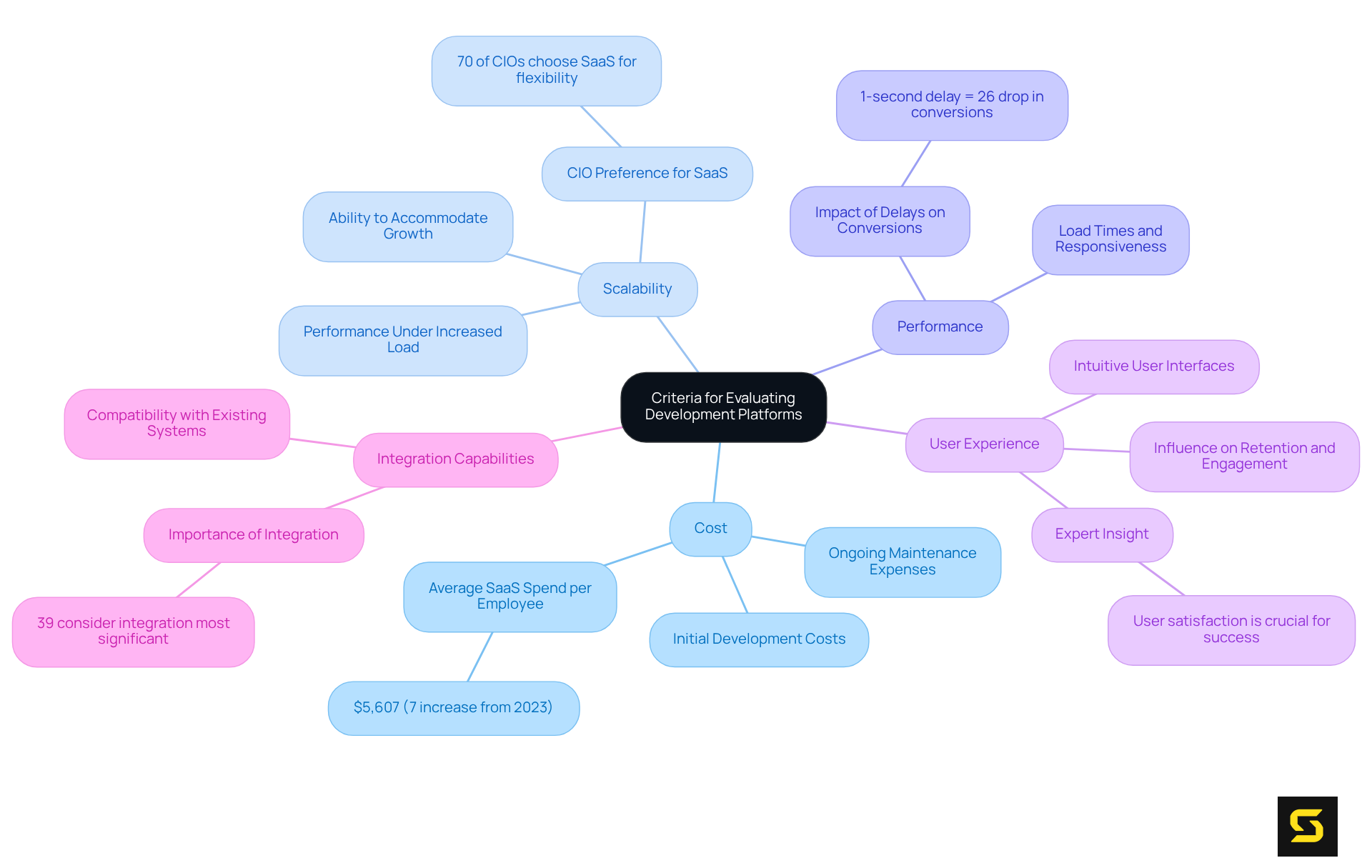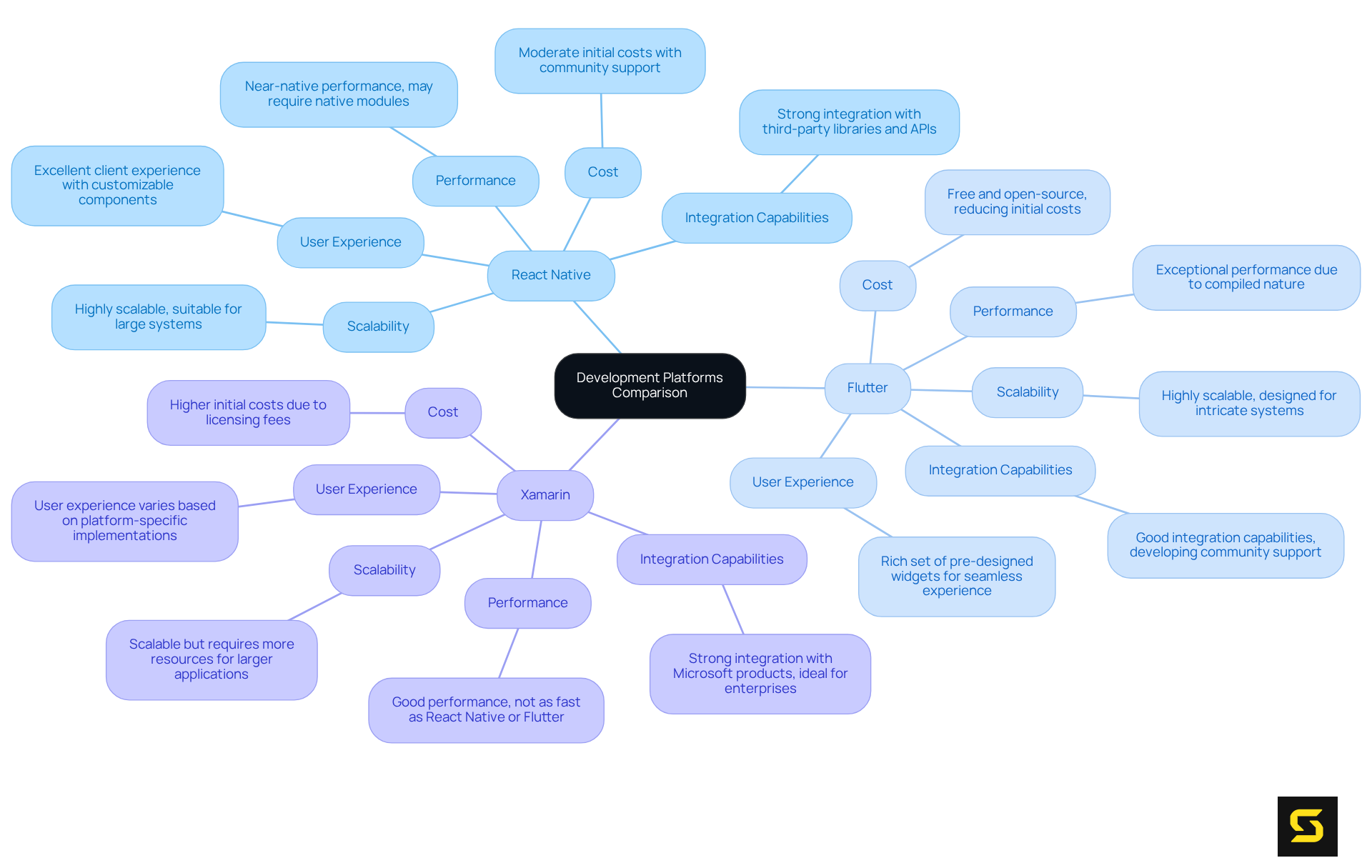Overview
The article presents a compelling overview of mobile application development platforms tailored for SaaS owners, emphasizing the critical nature of choosing the right framework to enhance scalability, performance, and user experience.
It meticulously analyzes three leading platforms—React Native, Flutter, and Xamarin—evaluating essential factors such as:
- Costs
- Scalability
- Performance
- User experience
- Integration capabilities
This comprehensive examination equips SaaS proprietors with vital insights, empowering them to make informed decisions that align seamlessly with their business objectives.
Introduction
Mobile application development platforms have emerged as essential tools for Software as a Service (SaaS) owners looking to elevate their offerings in a competitive landscape. These platforms not only streamline the development process but also play a crucial role in enhancing the scalability, performance, and user experience of mobile applications.
As businesses navigate the complexities of evolving market demands, the challenge lies in selecting the right platform that effectively balances cost, efficiency, and functionality.
What criteria should SaaS proprietors prioritize to ensure their chosen development framework aligns with their strategic goals and maximizes user satisfaction?
Understanding Mobile Application Development Platforms
Mobile application development platforms serve as essential tools that empower the creation, deployment, and management of mobile software. These systems provide developers with a comprehensive suite of tools, libraries, and services designed to streamline the development process, facilitating the effective creation of software across diverse mobile operating systems, such as iOS and Android. For SaaS proprietors, understanding these frameworks is not just beneficial; it is crucial, as they significantly impact the scalability, performance, and user experience of their services. Selecting the right solution can enhance operational efficiency and minimize time-to-market, positioning businesses strategically to leverage mobile technology effectively.
Industry leaders emphasize that utilizing these frameworks can lead to substantial improvements in software performance and scalability, ultimately driving business growth and enhancing customer satisfaction. However, the risks of choosing an inappropriate tech stack cannot be overlooked; it can lead to project delays and client dissatisfaction. This underscores the importance of thoughtful consideration in platform selection. As the SaaS landscape evolves, the integration of robust mobile application development platforms becomes increasingly vital, enabling businesses to swiftly adapt to market demands and user expectations.

Types of Mobile Application Development Platforms
There are three primary types of mobile application development platforms that every developer should understand:
-
Native Development Frameworks: These frameworks empower developers to create software tailored specifically for one operating system, either iOS or Android, utilizing system-specific languages such as Swift for iOS and Kotlin for Android. Native applications typically deliver superior performance and an enhanced user experience, but they require distinct codebases for each operating system, which can increase development time and costs.
-
Hybrid Development Systems: Hybrid systems blend elements of both native and web applications, allowing developers to write code once and deploy it across multiple environments. Technologies like HTML, CSS, and JavaScript are employed in this approach. While hybrid apps can expedite development timelines, it's important to note that they may not match the performance levels of their native counterparts.
-
Cross-Operating System Development Tools: These tools facilitate the creation of software that functions across various operating systems from a single codebase. Popular frameworks like React Native and Flutter strike a balance between performance and development efficiency. Cross-platform solutions are particularly appealing for software-as-a-service providers looking to reach a broader audience without the financial burden of managing separate codebases.
Understanding mobile application development platforms is crucial for making informed decisions about mobile application development strategies, thereby enhancing your competitive edge in the market.

Criteria for Evaluating Development Platforms
When evaluating mobile application development platforms, SaaS owners must prioritize essential criteria to ensure effective decision-making:
-
Cost: A comprehensive analysis of both initial development costs and ongoing maintenance expenses is imperative. While some services may present lower initial costs, they can lead to higher long-term expenditures, ultimately impacting budget effectiveness. Notably, the average software as a service expenditure per employee is $5,607, reflecting a 7% increase from 2023. This statistic underscores the necessity of understanding total expenses involved.
-
Scalability: It is crucial to confirm that the system can effectively accommodate growth. This includes the ability to introduce new functionalities and manage increased application loads without significant performance degradation—a common challenge faced by software-as-a-service solutions. In fact, 70% of Chief Information Officers (CIOs) opt for SaaS due to its flexibility and scalability, highlighting its vital role in the selection process.
-
Performance: Assess the system's capability to maintain optimal app efficiency, focusing on load times, responsiveness, and the overall user experience. A mere one-second delay in page load time can lead to a 26% drop in conversions, emphasizing the critical role of performance in retaining visitors.
-
User Experience: Analyze the platform's ability to foster intuitive and engaging user interfaces. User satisfaction is paramount for the success of any software service, as it directly influences retention and engagement rates. As industry experts assert, "User satisfaction is crucial for the success of any software service."
-
Integration Capabilities: Evaluate how well the platform integrates with existing systems and third-party services. Effective integration is essential for software solutions that depend on diverse data sources and functionalities, facilitating smooth operations and enhanced user experiences. Moreover, 39% of buyers consider integration with their current software as the most significant factor when selecting a software provider.
By focusing on these criteria, SaaS owners can make informed decisions that align with their strategic objectives and enhance their software's competitiveness in the market through mobile application development platforms.

Comparative Analysis of Leading Development Platforms
In this comparative analysis, we will examine three leading mobile application development platforms: React Native, Flutter, and Xamarin.
-
React Native:
- Cost: Moderate initial costs with a large community support reducing long-term expenses.
- Scalability: Highly scalable, suitable for large systems.
- Performance: Near-native performance, but may require native modules for complex functionalities.
- User Experience: Excellent client experience with customizable components.
- Integration Capabilities: Strong integration with third-party libraries and APIs.
-
Flutter:
- Cost: Free and open-source, reducing initial costs significantly.
- Scalability: Highly scalable, designed for intricate systems.
- Performance: Exceptional performance due to its compiled nature.
- User Experience: Offers a rich set of pre-designed widgets for a seamless user experience.
- Integration Capabilities: Good integration capabilities, though still developing community support.
-
Xamarin:
- Cost: Higher initial costs due to licensing fees.
- Scalability: Scalable but may require more resources for larger applications.
- Performance: Good performance, but not as fast as React Native or Flutter.
- User Experience: User experience can vary based on platform-specific implementations.
- Integration Capabilities: Strong integration with Microsoft products, making it ideal for enterprises already using Microsoft technologies.
This analysis highlights the strengths and weaknesses of each mobile application development platform, allowing SaaS owners to make informed decisions based on their specific requirements.

Conclusion
Understanding mobile application development platforms is essential for SaaS owners aiming to enhance their services and meet user demands effectively. The right platform can significantly influence the scalability, performance, and overall user experience of mobile applications. Therefore, making an informed choice is crucial for leveraging mobile technology to its fullest potential.
This article delves into the various types of mobile application development platforms, including:
- Native
- Hybrid
- Cross-operating systems
Each type presents unique advantages and challenges that SaaS owners must consider. Furthermore, the criteria for evaluating these platforms—such as cost, scalability, performance, user experience, and integration capabilities—serve as a guide for making strategic decisions that align with business objectives.
Ultimately, the choice of a mobile application development platform can profoundly impact a SaaS business's success. By carefully assessing the available options and their respective strengths, SaaS owners can position themselves to adapt swiftly to changing market dynamics and user expectations. Embracing the right technology not only streamlines development but also enhances customer satisfaction, driving growth and fostering long-term success in the competitive SaaS landscape.
Frequently Asked Questions
What are mobile application development platforms?
Mobile application development platforms are tools that facilitate the creation, deployment, and management of mobile software, providing developers with a suite of tools, libraries, and services to streamline the development process.
Why are these platforms important for SaaS proprietors?
Understanding mobile application development platforms is crucial for SaaS proprietors as they significantly impact the scalability, performance, and user experience of their services.
How can selecting the right mobile application development platform benefit a business?
Choosing the right platform can enhance operational efficiency, minimize time-to-market, and position businesses to leverage mobile technology effectively.
What improvements can be expected from utilizing these frameworks?
Utilizing mobile application development platforms can lead to substantial improvements in software performance and scalability, driving business growth and enhancing customer satisfaction.
What are the risks of choosing an inappropriate tech stack?
Selecting an inappropriate tech stack can result in project delays and client dissatisfaction, highlighting the need for careful consideration in platform selection.
How does the evolution of the SaaS landscape affect the importance of these platforms?
As the SaaS landscape evolves, the integration of robust mobile application development platforms becomes increasingly vital, enabling businesses to adapt swiftly to market demands and user expectations.





